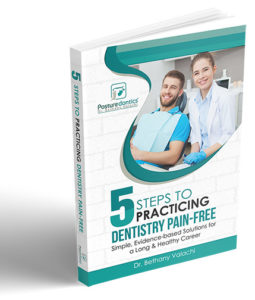-Dr. Bethany Valachi-
Prolonged, awkward postures are the greatest culprits for the demise of dentist’s musculoskeletal health1. Sustained muscle contractions can cause painful muscle ischemia and the development of “tender spots”, or trigger points in muscles2. Even in “perfect” seated posture, more than half of the muscles in your body are in a sustained contraction. These muscles can become ischemic and vertebral joints deprived of movement, which is essential to nourishment of the disc.
Complicating the problem are unbalanced operating postures to visualize the working surface, which are usually in one direction. Most right-handed dentists tend to lean forward and to the right for two-thirds of their working time3. Many dental professionals lose flexibility of the neck with sidebending to the left and rotation to the right. In general, dental operators tend to lose flexibility in those directions opposite to which they are postured statically during the day4. Over time, this can cause muscle imbalances (tightness in one group of muscles, and weakness in the opposing group), and lead to a plethora of musculoskeletal pain syndromes. While the body is designed to tolerate brief awkward postures, it is not designed to hold these awkward postures for several minutes or more at a time throughout the day.
Since men tend to be more prone to musculoskeletal disorders due to poor flexibility than women, chairside stretching is especially imperative for the health and career longevity of male dentists.
Chairside Stretching
Research reveals that taking frequent breaks5 and moving are integral to an effective injury prevention program and pain control in dentistry.
Frequent chairside stretching is the only strategy I am aware of that addresses every microtrauma that results from prolonged, static postures in dentistry: ischemia, trigger points, muscle imbalances, joint hypomobility, nerve compression, and disc degeneration. The time commitment is minimal (only 10-20 seconds) and the benefits of stretching are numerous.
An effective chairside stretching program in dentistry targets primarily those muscles and structures that are prone to ischemia and tightness in dental professionals. Not all stretches are appropriate for dental professionals.
HIGHLIGHTS from
CHAIRSIDE STRETCHING CE VIDEO COURSE
Access all of 20 chairside stretches in this CE Video Course:
Chairside Stretching for Dental Professionals
Stretching Safely
To avoid injury during stretching, keep the following tips in mind:
- Assume the starting position for the stretch
- Breathe in deeply & exhale as you slowly increase the intensity of the stretch up to a point of mild tension or discomfort
- Hold the stretch for 2-4 breathing cycles (10-20 seconds)
- Repeat the stretch, if time allows.
- Try the stretch in both directions, and determine which side is tightest. Perform the directional stretch primarily toward the tightest side throughout the workday, and place stretching charts where you can easily reference them while chairside. At home and on weekends, perform stretches in both directions.
- Never stretch in a painful range. If stretching increases your pain, stop immediately.
Stretching during Microbreaks
The body is constantly repairing microtrauma that occurs during the workday, however if stretch breaks are too far apart, the rate of damage will exceed the rate of repair, ultimately resulting in breakdown of tissue. A schedule of brief, yet frequent rest periods is more beneficial to workers than lengthy infrequent rest periods. Therefore, chairside stretches should be performed every 45 minutes throughout the day.
Now is the perfect time to take charge of your musculoskeletal health. Taking short, frequent breaks and reversing your operator position with chairside stretching are essential keys to ensuring your career longevity and attaining your optimal musculoskeletal health. Muscles are like leather shoes-the more you use them, the better they feel.
References
- Valachi B, Valachi K. Mechanisms leading to musculoskeletal disorders in dentistry. Journal of the American Dental Association 2003;10:1344-50.
- Travell JG, Simons DG, Simons LS. Myofascial Pain and Dysfunction: The Trigger Point Manual, Vol. 1. Baltimore, Maryland: Lippincott Williams & Wilkins; 1999:4, 12 19, 35
- Kihara T. Dental care works and work-related complaints of dentists. Kurume Medical Journal. 1995;42:251-257.
- Rundcrantz B, Johnsson B, Moritz U. Occupational cervico-brachial disorders among dentists. Swedish Dental Journal 1991; 15:105-115.
- Rundcrantz B, Johnsson B, Moritz U. Cervical pain and discomfort among dentists. Epidemiological, clinical and therapeutic aspects. Swedish Dental Journal 1990; 14:71-80.
Copyright 2017 Posturedontics, LLC . All rights reserved.

 How can you protect your back, neck, shoulders, and hands for a long and healthy career?
How can you protect your back, neck, shoulders, and hands for a long and healthy career?
